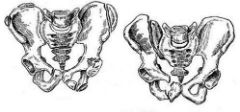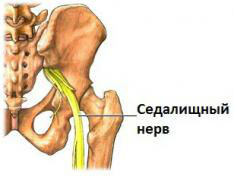





Ischium change
Anatomically the ischium is placed in a back and lower part of an acetabular hollow, consists of a body and branches. The branch departing from her body has a thickening – a sciatic hillock, and the lower part is spliced with the lower branch of a pubic bone. Strong reductions of muscles owing to not coordinated gusty movements, and also can lead falling on sciatic hillocks to ischium changes.
Ischium change: treatment and diagnosis
 When falling such types of changes of an ischium as changes of sciatic hillocks, unilateral and bilateral vertical changes of a basin are most extended to sciatic hillocks. As a result strong reductions of muscles rather often there are ischium changes in the form of avulsion fractures of ileal bones of a hillock.
When falling such types of changes of an ischium as changes of sciatic hillocks, unilateral and bilateral vertical changes of a basin are most extended to sciatic hillocks. As a result strong reductions of muscles rather often there are ischium changes in the form of avulsion fractures of ileal bones of a hillock.
Changes of an ischium represent rather severe injuries of a musculoskeletal system of the person, and their frequency makes about 10% of all traumatologic damages.
If the isolated ischium change takes place, then the forecast of a course of such damage is favorable, and the risk of complications is minimum. Such changes arise generally owing to direct traumatizing.
The closed changes of an ischium can be both single, and multiple. If the change single, then is most often injured the front half ring in the form of a butterfly formed by ischiums.
Extremely often changes of ischiums develop owing to falling on buttocks or squeezings of a basin. Patients complain of pains in the field of falling which amplify at the movement of the lower extremities, in particular when bending a shin.
Correct collecting all details of the anamnesis of an injury, especially poses is important for adequate diagnosis of changes of ischiums when falling. Survey of the patient is also necessary. Patients not always are in consciousness owing to painful shock, and such external manifestations as hematomas in places of changes, quite often develop several hours later after an injury. Method of objective diagnosis of changes of ischiums is the X-ray analysis.
Treatment of changes of ischiums without fail includes the anesthetizing therapy. The most comfortable for patients is the dorsal decubitus in a pose of "frog": legs are bent in hip and knee joints, hips turn knaruzh, knees get divorced, and feet are closed. For the purpose of its providing both specialized orthopedic beds, and the usual beds equipped with special rollers can be used. Such rollers enclose to patients in the field of hip and knee joints.
Major importance in treatment is allocated for observance of a bed rest which duration makes not less than 4 weeks. At the same time recovery of functions of an affected extremity is possible after 7 weeks. Further rehabilitation in the form of physical therapy and physiotherapy exercises is recommended.
Effects of changes of an ischium
 At multiple fractures of ischiums development of various complications, and also an internal injury of patients – a bladder and an urethra, intestines, internal generative organs is possible. Quite often there can be most severe traumatic bleedings. Such changes arise at car accidents, building collapses, earthquakes.
At multiple fractures of ischiums development of various complications, and also an internal injury of patients – a bladder and an urethra, intestines, internal generative organs is possible. Quite often there can be most severe traumatic bleedings. Such changes arise at car accidents, building collapses, earthquakes.
The posttraumatic infection and even sepsis, delay of accretion of bones, and also the wrong accretion or nonunion can become effects of changes of ischiums.
Also in the field of a change damage of vessels, muscles, nerves and sinews, development of paresthesias owing to a traumatic compression, osteomyelites and osteoarthrites can be noted.
In the most hard cases shortenings of extremities, an atrophy and a hypotrophy of gluteuses, a contracture of hip joints can develop.
Our kidneys are capable to clear three liters of blood in one minute.

Kidneys perform the most important function of clarification of blood from those products of metabolic processes which cannot be used орг...
Section: Articles about health
Transfusion of donor blood has almost century history. In spite of the fact that this procedure is quite usual for many people, process of blood donation is still surrounded with numerous myths. Today we aimed to discredit the most widespread of them....
Section: Articles about health
Very often as a source of the infection which caused a disease serves our house - the place which a priori has to be safe. However disease-producing bacteria can perfectly feel not only in insanitary conditions, but also in our apartment if not to carry out due care of favourite places of their dwelling. What they − sources of their reproduction? Let's consider 10 most widespread places in our house, the most dangerous from the point of view of infection with microorganisms....
Section: Articles about health
Coffee – favourite drink of many. For the last decades it more than once already declared very harmful, extremely useful and even...
Section: Articles about health
Within several decades of our compatriots convinced that the use of butter nasty affects a condition of coronary vessels. As a result the reputation of a product was impaired thoroughly a little, and many almost ceased to include...
Section: Articles about health
Dietary supplements (dietary supplements) for the last decades were so thoroughly included into our life that, apparently, it is already impossible to find the person who at least once did not try them. At the same time, most of our compatriots have a vague idea of what dietary supplements as they affect a human body consist of and what differ from the real medicines in. Let's try to understand these questions, and at the same time and to understand, such additives are how necessary for us....
Section: Articles about health
There is an opinion that at low temperatures safety of products is ensured longer and better thanks to what the refrigerator considers...
Section: Articles about health
For the person who daily since morning gathers for work it is very important to wake up vigorous and ready by day of work. Actually, each of us experiences difficulties with this, at first sight, simple business from time to time. On a condition of an organism after ночн...
Section: Articles about health
Epilepsy is one of widespread neurologic diseases. Parents, whose children suffer from this illness, should face rumors and delusions, many of which remained since the Middle Ages....
Section: Articles about health
For the last decades the diabetes mellitus of the second type became really world problem. Number of cases annually cart...
Section: Articles about health
The immunity role in growth of the child is invaluable. The proteins-immunoglobulins produced by immune system preserve the child against the diseases capable − owing to an organism weak still − to serve as a stressful factor, to become the reason of many complications and delays in unless...
Section: Articles about health
Is told about advantage of domestic animals for development of the child much. But many parents nevertheless do not hurry to bring pets as are afraid that they can do harm to health of children. What troubles can really trap kids and how to make joint life of a family and domestic animals comfortable and safe?...
Section: Articles about health
On health of the person physicians know about salutary action of animals long ago. About 7 thousand years ago great Hippocrates рекоменд...
Section: Articles about health
Any of us is not insured from a heavy illness of the loved one. Happens and so that someone from family members becomes the bed patient, and remains in such state for a long time. It extremely suppresses both the most injured, and all it to...
Section: Articles about health
The drugs stopping or oppressing life activity of pathogenic microorganisms are widely applied in clinical practice from 40th years of the last century. Originally antibiotics were called only substances natural (animal, vegetable or microbic) origins, but over time this concept extended, and it includes also semi-synthetic and completely artificial antibacterial drugs....
Section: Articles about health
Smack in a mouth can arise in the natural way – as a result of lack of morning hygiene or reception of the corresponding food. Odn...
Section: Articles about health
All parents are ready to what the baby often and pisat much. Since then, as the absorbing diapers strongly became current, keeping of the kid in dryness does not represent any problems. But if the grown-up kid continues to urinate in panties, parents of a nacha...
Section: Articles about health
Small appetite at the child – the complaint which pediatricians should hear practically from each mother. Most often it is carried to the category of children's whims, however the refusal of food in certain cases can be to alarming symptoms therefore it cannot be ignored....
Section: Articles about health
Long time antibiotics were considered as a panacea from all diseases and were appointed even at insignificant symptoms of an infection. Even now...
Section: Articles about health
All like to sing. Small children with pleasure are engaged in a vocal, not especially thinking of hit in a melody. Adults most often hesitate, being afraid to show lack of talents in this area, and it is vain: singing is very useful for health....
Section: Articles about health
A little more than a century ago goat milk was a traditional food stuff of most of Russians. Unfortunately, today on tables of our compatriots it appears extremely seldom. The reason that the use of so useful product practically came to naught, not only in very modest volumes of its production and, respectively, rather high cost. Potential consumers are just insufficiently informed on unique properties of goat milk and that advantage which...
Section: Articles about health
Partial and the more so full loss of hearing significantly reduces quality of life. Difficulties with communication lead to loneliness and замкн...
Section: Articles about health
Herpes simplex of the first type (the infectious disease which is shown periodic bubble rashes on lips is called) – one of the most widespread illnesses. Statistically, only 5% of inhabitants of our planet are unreceptive to its activator, and...
Section: Articles about health
During foot walks blood moves on vessels more actively and one and all bodies are supplied with a large amount of oxygen. It affects the state of health of the person very positively....
Section: Slideshow
Life of the modern child is extremely active and difficult. Information strain which is experienced by the school student and did not dream the pupil...
Section: Articles about health
It would seem, about it there can be no disagreements: water is necessary for a human body for normal life activity, and about how and when it should be drunk, all know. It turned out that the situation is not absolutely so: for many years occur ве...
Section: Articles about health
Helminthosis is one of the most widespread diseases. Statistically, any species of helminths infected every third inhabitant of the planet. Most of specialists even consider these data strongly underestimated: some uninvited "cohabitants" do not cause the carriers serious troubles, and patients just do not see doctors. The situation is aggravated also with the fact that people know about specifics of similar illnesses very little. At many presence of worms is strong ассоциир...
Section: Articles about health
